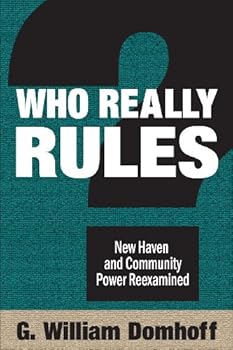Who Really Rules?: New Haven and Community Power Re-examined
Select Format
Select Condition 
Book Overview
Robert A. Dahl's Who Governs? is a classic pluralist study which has had an important influence on American social science since the early sixties. Who Really Rules? provides a categorical challenge-empirical, methodological, and theoretical-to Dahl's work. Empirically, Domhoff's restudy of New Haven shows through newly discovered documents that Dahl was wrong about the pluralism of New Haven's power structure. He also presents the most systematic...
Format:Paperback
Language:English
ISBN:0876209657
ISBN13:9780876209653
Release Date:January 1978
Publisher:Routledge
Length:204 Pages
Weight:0.70 lbs.
Dimensions:0.4" x 6.0" x 9.0"
Customer Reviews
1 rating
Brilliant: a clear look at how power really works
Published by Thriftbooks.com User , 14 years ago
This is one of my very favorite books. But explaining why will take some background. In the 1950s and 60s researchers were looking at what they called the "power structure" in American cities -- the people who really pulled the strings and called the shots. Foremost among them was Floyd Hunter, whose study of Atlanta practically invented the field. Naturally the whole notion that anyone was pulling the shots behind the scenes in America offended the deans of mainstream liberal political science and so their leader, Robert A. Dahl, set out to defend democracy's good name. He argued that one could only figure out who was in charge by doing careful case studies -- looking at controversial decisions and seeing who was involved in making them -- that and only that could tell you where true power lay. And, in his most famous work, Who Governs?: Democracy and Power in an American City, he aimed to do just such a case study in his hometown of New Haven, where his employer, Yale University, resides. Dahl claimed no "secret cabal of Notables dominates the public life of New Haven through means so clandestine that not one of the fifty prominent citizens interviewed in the courts of this study--citizens who had participated extensively in various decisions--hinted at the existence of such a cabal; so clandestine, indeed, that no clues turned up in several years of investigation led to the door of such a group." (185) Of course that wasn't quite true. Domhoff was skeptical of Dahl's results and decided to request access to his source material and reresearch the matter for himself. In going through Dahl's interview notes, Domhoff found informants not just hinting at it, but saying it outright. "Sounds like a quote from Hunter," one of Dahl's assistants noted about one comment. And thus Dahl's story begins to unravel. Domhoff follows the thread all the way true, disproving all of Dahl's claims and, in the process, telling an alternative history of American urban renewal -- which Domhoff makes into a thrilling story about how big business turned a plan to build housing for the poor into an excuse to expel them to make room for upscale businesses. It's an engrossing case study of how powerful businessmen get things like this done, based on extensive archival research and contemporaneous notes. The result is a tour de force: a complete demolition of one of the most influential books of political science, an engrossing case study of how power really operates, and an example of how to do research into the people who, after all, really rule. [...]




